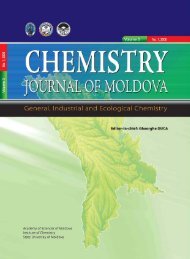2011, nr. 3 - Academia de ÅtiinÅ£e a Moldovei
2011, nr. 3 - Academia de ÅtiinÅ£e a Moldovei
2011, nr. 3 - Academia de ÅtiinÅ£e a Moldovei
Create successful ePaper yourself
Turn your PDF publications into a flip-book with our unique Google optimized e-Paper software.
234loci for Crohn’s disease and implicates autophagy in diseasepathogenesis. In: Nat. Genet., 2007, 39, p. 596-604.29. Lakatos P.L., Fischer S., Lakatos L. et al., Currentconcept on the pathogenesis of IBD: crosstalk between geneticand microbial factors. Pathogenic bacteria, alteredbacterial sensing or changes in mucosal integrity take“toll”? In: World J. Gastroenterol., 2006, 12, 1829-1840.30. Makharia G.K., Sood A. Midha V., A randomizeddouble blind, placebo-controlled trial of a probioticpreparation, VSL#3, for the treatment of mild to mo<strong>de</strong>rateactive ulcerative colitis. In: Gastroenterol., 2008, 701, p.861-866.31. Hafner S., Timmer A., Herfart H. et al., The role ofdomestic hygiene in infl ammatory bowel disease: hepatitisA and worm infestation. In: Eur. J. Gastroenterol. Hepatol.,2008, 20, p. 561-566.32. Buening J., Homann N., von Smolinski D. et al.,Helmints as governors of infl ammatory bowel disease. In:Gut, 2008, 57, p. 1182-1183.33. Summers R.W., Elliott D.E., Urban J.F. et al.,Trichuris suis therapy for active ulcerative colitis: a randomizedcontrolled trial. In: Gastroenterol., 2005, 128, p.825-832.34. Bach J.F., The effect of infections on susceptibilityto autoimmune and allergic diseases. In: N. Engl. J. Med.,2002, 347, p. 911-920.35. Russel M.G.V.M., Engels L.G., Muris J.W. et al.,“Mo<strong>de</strong>rn life” in the epi<strong>de</strong>miology of infl ammatory boweldisease: a case-control study with special emphasis on nutritionalfactors. In: Eur. J. Gastroenterol. Hepatol., 2008,10, p. 243-249.36. Bernstein C.N., Rawsthorne P., Cheang M. et al.,A population-based case control study of potential risk fctorsfor IBD. In: Am. J. Gastroenterol., 2006, 101, p. 993-1002.37. Dubinsky M., What is the role of serological markersin IBD? Pediatric and adult data. In: Dig. Dis., 2009,27(3), p. 259-268.38. Бочков Н.П., Генетические основы болезнейкишечника. B: Российский журнал гастроэнтерологии,гепатологии, колопроктологии, 1999, 6, c. 7-13.RezumatArticolul reflectă opiniile mo<strong>de</strong>rne privind mecanismelepatogenice ale bolilor inflamatorii intestinale. Suntanalizate ipotezele patogenetice actuale şi rolul factorilorgenetici şi imunologici, inclusiv caracteristicile <strong>de</strong> imunitateînnăscută şi adaptivă. Sunt <strong>de</strong>scrise mecanismele posibile<strong>de</strong> influenţă a <strong>de</strong>reglărilor <strong>de</strong> microfloră intestinală şia factorilor mediului asupra apariţiei şi progresiei <strong>de</strong> inflamaţiecronică nespecifică în intestin.SummaryIn the article is reflected current view on the pathogeneticmechanisms of the onset and progression of inflammatorybowel disease. Actual pathogenetic hypotheses areexamined and the role of genetic and immunological factorsincluding characteristics of innate and adaptive immunityis analyzed. Possible mechanisms of influence of intestinalmicroflora and environmental factors on the initiation andprogression of chronic nonspecific inflammation of theintestine are <strong>de</strong>scribed.Buletinul AŞMРезюмеВ статье отражены современные взгляды на патогенетическиемеханизмы возникновения и прогрессированиявоспалительных заболеваний кишечника.Рассмотрены актуальные патогенетические гипотезы ипроанализирована роль генетических и иммунологическихфакторов, в том числе особенностей врожденногои приобретенного иммунитета. Описаны возможныемеханизмы влияния изменений микрофлоры кишечникаи факторов окружающей среды на возникновениеи прогрессирование хронического неспецифическоговоспаления в кишечнике.HEPATITA CRONICĂ VIRALĂ CŞI STAREA FUNCŢIONALĂA GLANDEI TIROIDE_______________________________________Iulianna Lupaşco, dr. în medicină, conf. cercet.USMF „Nicolae Testemiţanu”Introducere.Hepatitele cronice şi cirozele hepatice reprezintăo problemă majoră a hepatologie mo<strong>de</strong>rne [4]. Oparticularitate a infecţiei cu VHC cronică este <strong>de</strong>zvoltareamanifestărilor sistemice extrahepatice, careagravează evoluţia bolii <strong>de</strong> bază [5]. Starea funcţionalăa glan<strong>de</strong>i tiroi<strong>de</strong> în HC <strong>de</strong> etiologie VHC esteimportantă, <strong>de</strong>oarece funcţia tiroidiană <strong>de</strong>termină, înmare parte, starea echilibrului imunologic al întreguluiorganism şi prin mecanisme indirecte influenţeazăevoluţia bolii hepatice. După datele diferitelor autorifrecvenţa afecţiunilor tiroidiene în HC <strong>de</strong> etiologieVHC variază <strong>de</strong> la 9.3% până la 25% [1, 7] până laadministrarea tratamentului antiviral şi creşte pe parcursulinterferonoterapiei.Scopul studiului: studierea particularităţilor cliniceşi <strong>de</strong> laborator la pacienţii cu hepatită cronicăvirală C cu diferit statut tiroidian.Material şi meto<strong>de</strong>. Au fost investigaţi 127 pacienţicu hepatită cronică virală C şi 30 <strong>de</strong> persoanesănătoase. La toţi pacienţii s-au <strong>de</strong>terminat markeriiserologici pentru infecţiile VHC şi VHB prin metodaimunoenzimatică, folosind seturi ELISA. Activitateainfecţiei virale a fost apreciată prin <strong>de</strong>terminarea încărcăturiivirale VHC prin metoda PCR în timp real.Starea funcţională a ficatului a fost studiată prin <strong>de</strong>terminareacomplexului <strong>de</strong> teste ce reflectă sindroamele<strong>de</strong> citoliză, colestază, hepato<strong>de</strong>presiv. Funcţia glan<strong>de</strong>itiroi<strong>de</strong> a fost apreciată prin testarea tiroxinei (T4),triiodtironinei (T3), hormonului tireotrop (TSH), cutestatrea concomitentă la anticorpi antitiroidieni: antitireoperoxidazăşi antitireoglobulină (prin metodaELISA).
















